
Grindelia (gumweed) is a genus of plants native to the Americas belonging to the family Asteraceae. The genus was named for Latvian botanist David Hieronymus Grindel, 1776–1836.
Erigeron elegantulus is a North American species of flowering plants in the family Asteraceae known by the common names blue dwarf fleabane and volcanic daisy.
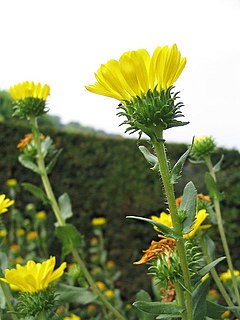
Grindelia camporum is a species of flowering plant in the daisy family known by the common names Great Valley gumplant and Great Valley gumweed.

Grindelia hirsutula is a North American species of flowering plant in the family Asteraceae known by the common names hairy gumplant and hairy gumweed.

Grindelia nana is a species of flowering plant in the daisy family known by the common names Idaho gumplant and Idaho gumweed. It is native to western North America, especially the western United States, where it can be found in a number of dry habitats. This is a weedlike perennial herb growing mainly erect to heights between 20 centimeters and one meter. Its stems and foliage are mostly green with some reddish coloration. Leaves are up to 9 centimeters long. The tops of the stem branches bear flower heads one or two centimeters wide, which are bell-shaped with rounded bases. The head is a cup of green clawlike, curling or erect phyllaries.

Helianthus bolanderi is a species of sunflower known by the common names Bolander's sunflower and serpentine sunflower. It is native to California and Oregon, where it grows mainly in mountainous areas, often in serpentine soils. It has been found from southwestern Oregon as well as in northern and central California as far south as Santa Cruz County, with reports of a few isolated populations in southern California.

Hulsea algida is a species of flowering plant in the daisy family, known by the common name Pacific hulsea or alpine gold.

Layia chrysanthemoides is a species of flowering plant in the family Asteraceae known by the common name smooth tidytips, or smooth layia.

Artemisia suksdorfii is a North American species of sagebrush in the sunflower family. It is known by the common names coastal mugwort, coastal wormwood, and Suksdorf sagewort. It is native to coastal regions from British Columbia, Washington, Oregon, and northern California as far south as Sonoma County, with isolated populations on Santa Catalina Island in Los Angeles County.

Calycadenia multiglandulosa is a species of flowering plant in the family Asteraceae, known by the common names sticky calycadenia and sticky western rosinweed. It is endemic to California, where it is a common in the Coast Ranges and in the Sierra Nevada Foothills from Shasta County to Kern County.

Crepis modocensis is a species of flowering plant in the daisy family known by the common name Modoc hawksbeard.
Microseris bigelovii is a species of flowering plant in the aster family known by the common name coastal silverpuffs. It is native to the west coast of North America, where its range extends from the southern tip of Vancouver Island to the northern coast of California.
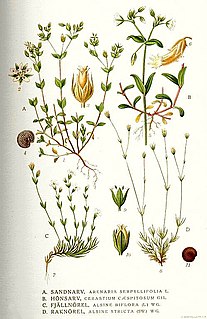
Minuartia stricta is a species of flowering plant in the family Caryophyllaceae known by the common names bog stitchwort, Teesdale sandwort and rock sandwort. It has a circumboreal distribution, occurring throughout much of the northernmost Northern Hemisphere from the lower Arctic into the alpine climates of mountainous areas in temperate Eurasia and North America. It grows in several types of habitat, including meadows, marshes, heath, beaches and bars, and arctic and alpine tundra.

Grindelia ciliata is a species of flowering plant in the family Asteraceae known by the common names Spanish gold, goldenweed, and waxed goldenweed.
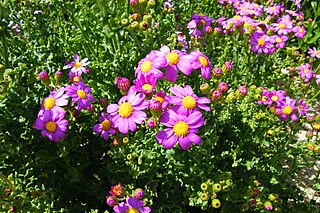
Senecio elegans is a species of flowering plant in the aster family known by the common names redpurple ragwort, purple groundsel, wild cineraria and purple ragwort.

Packera eurycephala is a species of flowering plant in the aster family known by the common name widehead groundsel. It is native to a section of the western United States encompassing southern Oregon, northern California, and northern Nevada. It can be found in dry habitat types, often in disturbed areas, and it favors serpentine soils.
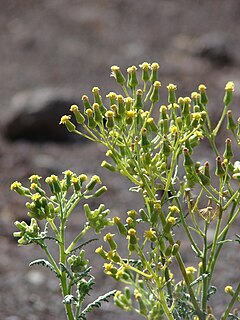
Senecio sylvaticus is a species of flowering plant in the aster family. It is variously known as the woodland ragwort, heath groundsel, or mountain common groundsel. It is native to Eurasia, and it can be found in other places, including western and eastern sections of North America, as an introduced species and an occasional roadside weed. It grows best in cool, wet areas. It is an annual herb producing a single erect stem up to 80 centimeters tall from a taproot. It is coated in short, curly hairs. The toothed, deeply lobed leaves are up to 12 centimeters long and borne on petioles. They are evenly distributed along the stem. The inflorescence is a wide, spreading array of many flower heads, each lined with green- or black-tipped phyllaries. The heads contain yellow disc florets and most have very tiny yellow ray florets as well.

Deinandra fasciculata, known by the common names clustered tarweed and fascicled spikeweed, is a species of flowering plant in the family Asteraceae native to western North America.
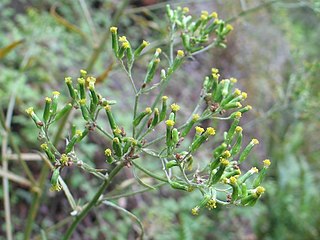
Erechtites minimus, common names toothed fireweed and coastal burnweed, is a species of plant in the sunflower family. It is native to Australia and New Zealand, and also naturalized on the Pacific Coast of the United States.

Grindelia fraxinipratensis, common name Ash Meadows gumweed, is a North American species of flowering plants in the family Asteraceae. It is native to the southwestern United States, in Mojave Desert regions in Nye County in Nevada and Inyo County in California. Some of the Nevada populations lie inside the Nevada Test Site of the United States Atomic Energy Commission



















